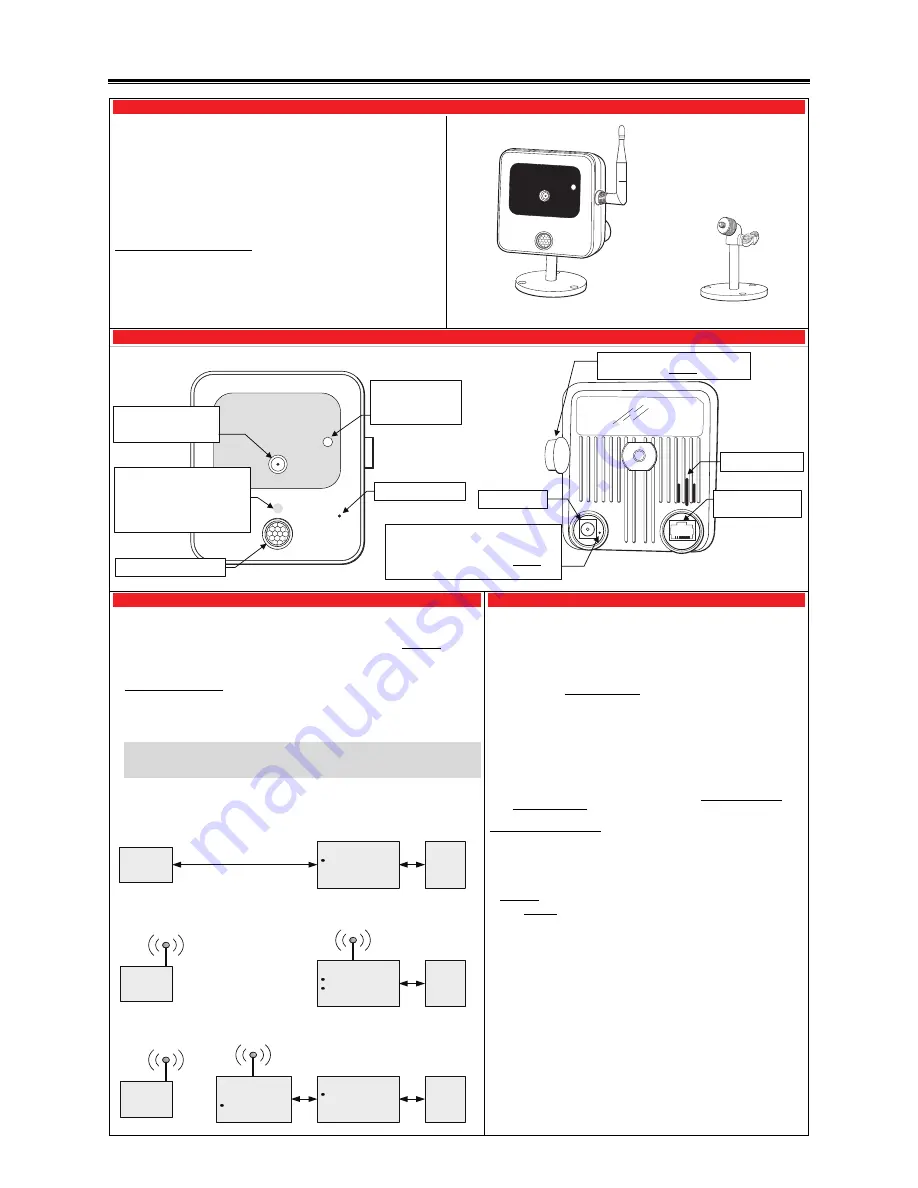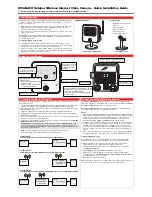
iPCAM-WO Outdoor Wireless Internet Video Camera – Quick Installation Guide
For Online Support visit: http://www.security.honeywell.com/hsc/resources/MyWebTech/
General Information
This guide provides information on installing and setting up Honeywell's iPCAM-WO Camera.
This camera is ideal for monitoring your home, business or public facilities. Some major
features of this camera are:
Wired or Wireless communications to a router or access point. Wireless communications
utilizes the 802.11n protocol with WPS security. WPS (Wi-Fi Protected Setup) is a
standard for easy setup of a secure wireless network.
Color video can be monitored through your Total Connect remote services account. Up to
6 cameras can be used.
LOCATION: This camera is for outdoor use, best location is under an eave or other structure
that will provide shelter from weather and birds. DO NOT mount this camera within one [1]
foot of any wireless device.
To utilize this camera, you must have:
An AlarmNet account for a GSM or Internet communicator, or a “Video Only” account.
Total Connect account. (If an account does not exist, the dealer should use the AlarmNet
Direct website to set up a Total Connect account for the customer.)
Internet access with a router capable of DHCP hosting. For wireless, the router must also
support one button WPS data encryption. If this is not available, order the Honeywell WAP
Wireless Access Point for connection to your router.
PACKAGE CONTENTS
Camera and Mounting Bracket
Additional items:
– Mounting bracket w/ screws [3]
– Antenna
– Power transformer
– Power cable with boot
– Ethernet port cover
– Ethernet cable with boot
Mounting Bracket
Component Identification
1. Assemble and Mount the Camera
2. Power and Configure Wireless Security
If a wireless connectivity is desired, it is recommended to first configure the wireless security. (Refer to
the information in step 2.)
1.
Assemble the mounting bracket consisting of the round base plate, threaded pole, and swivel head.
To prevent loosening you may apply thread sealant (not supplied) to the threads on the pole.
2.
Attach the camera to its mounting bracket. Ensure the swivel head’s screw post is fully seated in the
camera's threaded mount.
3.
Tighten the locking nut on the swivel head. Orient the camera, then tighten the thumb nut.
4.
If using wireless connectivity, attach the antenna to the camera. Orient the antenna vertically and
tighten the knurled connector.
5.
Secure the mounting bracket to the desired surface. Use all three holes on the base plate along with
screws that are suitable for the mounting surface.
6.
Connect the Power Transformer connector to the power connector on the camera back.
At this time
DO NOT plug the power transformer in.
IMPORTANT: In order for the camera to be placed in the wired mode, the Ethernet cable must be
connected first, then power applied. Likewise in order for the camera to be placed in the wireless
mode, ensure the Ethernet cable is NOT connected, then apply power. Follow the directions on the
right carefully for applying power.
NOTE: The Power Transformer must be powered by a non-switchable power outlet.
7.
Refer to the diagram below, and determine which configuration applies.
Configuration #3
Your wireless Router supports DHCP but DOES NOT support one button WPS encryption.
Camera
Router
DHCP capability.
Modem
Configuration #2
Your wireless Router supports DHCP and one button WPS encryption.
Camera
Router (wireless)
DHCP capability.
WPS button.
Modem
WAP Wireless
Access Point
WPS Button
Configuration #1
You are using a wired connection and your Router supports DHCP.
Camera
Router
DHCP capability.
Modem
If you have Configuration #1 –
Connect each camera to the router using an Ethernet
cable. Then plug the Power Transformer into an outlet. The camera installation is DONE.
If you have Configuration #2 –
Complete all the steps below.
If you have Configuration #3 –
You must attach the optional Honeywell WAP Wireless
Access Point to the router, then complete all the steps below.
NOTES:
When setting up a wireless configuration on very large buildings or buildings with dense
walls, wireless communications may be marginal. It is best to first configure the system
in the same room. Then upon successful configuration, place each camera in the
desired location. Check to see that all cameras exhibit good communications as
indicated by a STEADY GREEN or SLOW blinking Power/Network LED.
If using more than one wireless camera, each must be configured for wireless security.
If using a router instead of Honeywell's WAP, please ensure your router is configured
for DHCP. (This is the default setting for most routers.) If you are unsure, you can
access the router's configuration page and enable DHCP (refer to the router's manual).
Since the operation of each router varies, please refer to the router's manufacturer for
support.
Ensure the weather resistant boots are fully seated on the Power Connector cable and
the LAN Connector cable. If the LAN Connector is not used, install the protective cap.
Configuring Wireless Security:
When initially powered up, the camera and WAP use the same default AES key and
encryption parameters. To create a new AES key, please perform the steps below.
1.
Ensure an Ethernet cable is not connected to the camera, then plug the Power
Transformer into an outlet. Wait for the Power indicator to light solid.
2.
Press and hold the WPS button on the router, or WAP Wireless Access Point, for
3
seconds
, then RELEASE.
3.
Within
1
minute
, click and RELEASE the WPS button on the camera
.
4.
Allow up to 45 seconds for the WPS to complete, then verify successful wireless
security as indicated by the STEADY GREEN or SLOW blinking Power/Network LED. If
these indicators are present you are done.
5.
Repeat the steps above for each camera.
NOTE: If the camera is being used in a wireless mode and the Reset button on the back of
the camera is used, you must reconfigure wireless security for that camera.
Lens – Fixed lens requires
no focusing. Clean with a
soft tissue and lens cleaner.
Microphone – Not used.
Power/Network LED (green, visible
through housing)
Steady On – Initial condition when
power is applied.
Blinking – System startup period,
or accessing the network.
LAN Connector – Used
for wired connectivity.
Power Connector
Speaker – Not used.
Antenna Connector – Orient the antenna
vertically. Used for wireless connectivity.
Reset / WPS Button – Resets camera to default
settings. (Use a paper clip to depress and hold
for 12 seconds, then RELEASE.)
Also used during setup to configure wireless
WPS encryption.
Motion Sensor – Future use.
Photo Sensor – Detects
ambient light. Turns on
IR LEDs for low light
conditions.




















